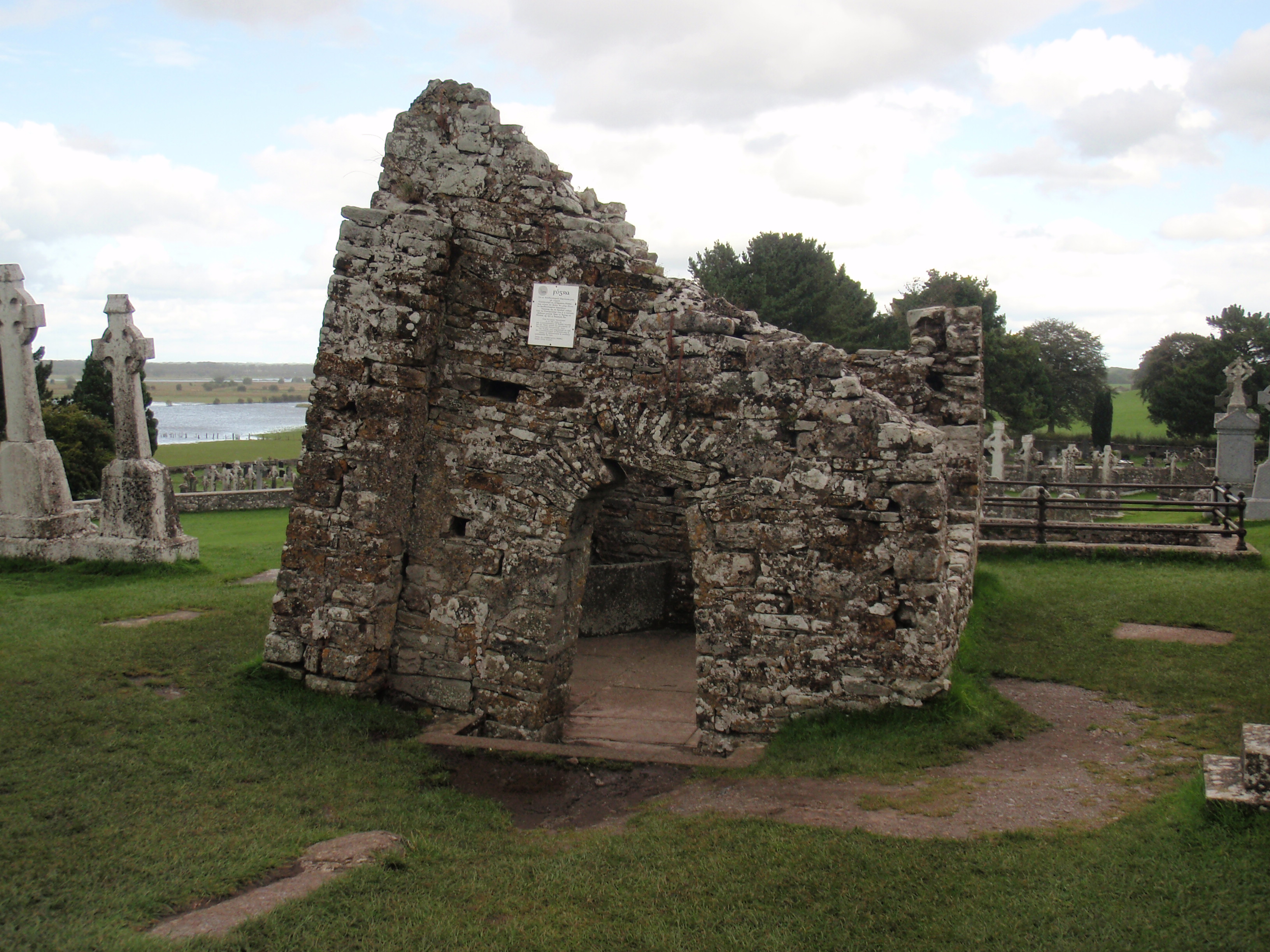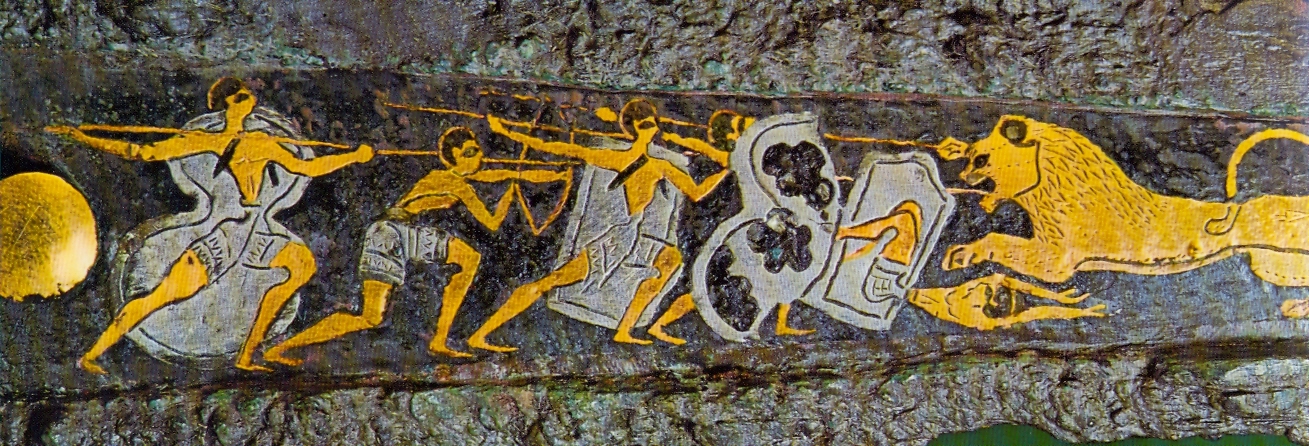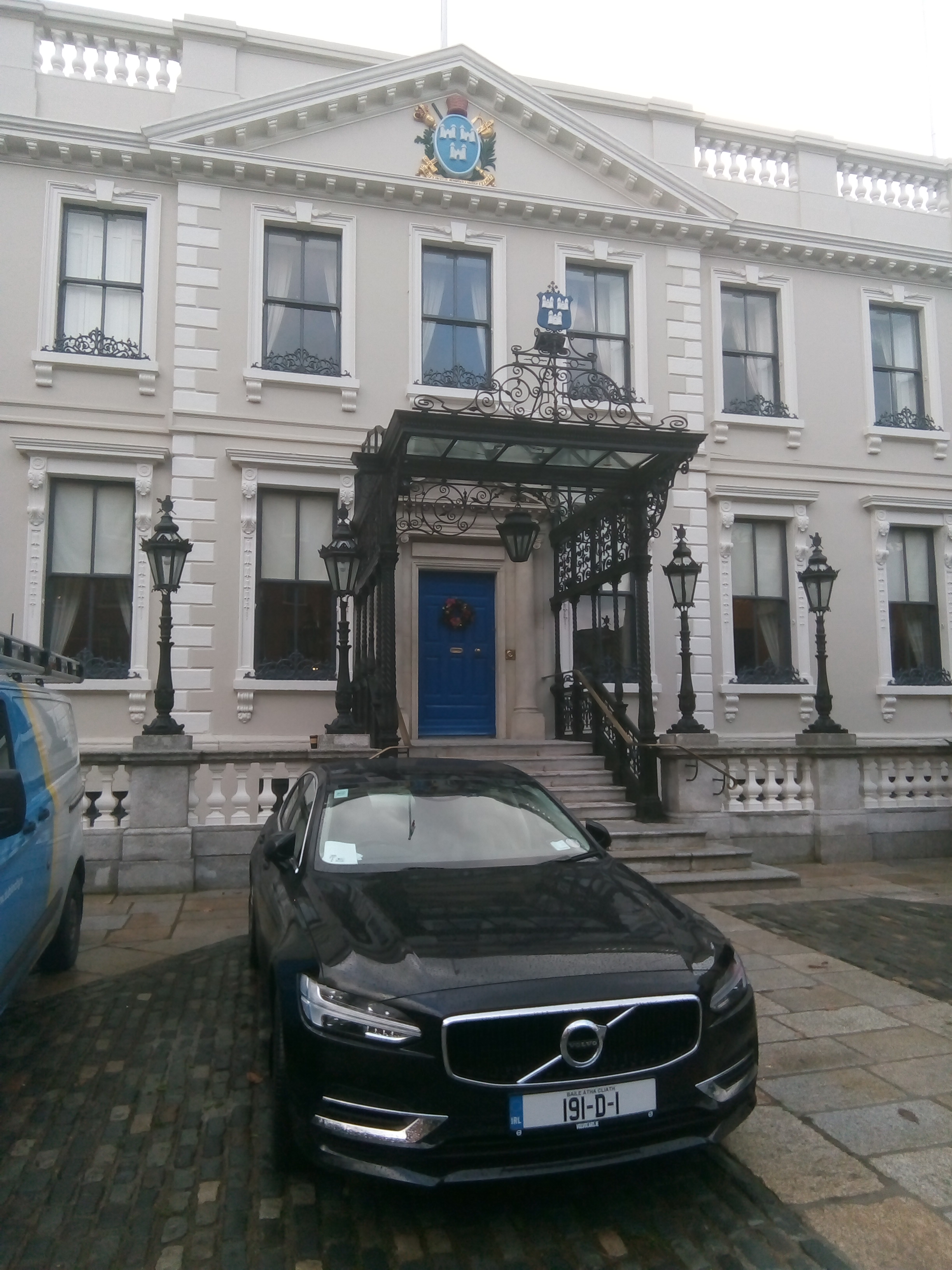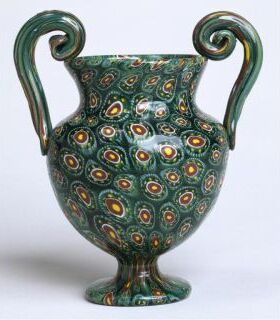|
Clonmacnoise Crozier
The Clonmacnoise Crozier is a late-11th-century Insular crozier that would have been used as a ceremonial staff for bishops and mitred abbots. Its origins and medieval provenance are unknown. It was likely discovered in the late 18th or early 19th century in the monastery of Clonmacnoise in County Offaly, Ireland. The crozier has two main parts: a long shaft and a curved crook. Its style reflects elements of Viking art, especially the snake-like animals in figure-of-eight patterns running on the sides of the body of the crook, and the ribbon of dog-like animals in openwork (ornamentation with openings or holes) that form the crest at its top. Apart from a shortening to the staff length and the loss of some inserted gems, it is largely intact and is one of the best-preserved surviving pieces of Insular metalwork. The crozier may have been associated with Saint Ciarán of Clonmacnoise (died CE), and was perhaps commissioned by Tigernach Ua Braín (died 1088), Abbot of Clonm ... [...More Info...] [...Related Items...] OR: [Wikipedia] [Google] [Baidu] |
Niello
Niello is a black mixture, usually of sulphur, copper, silver, and lead, used as an inlay on engraved or etched metal, especially silver. It is added as a powder or paste, then fired until it melts or at least softens, and flows or is pushed into the engraved lines in the metal. It hardens and blackens when cool, and the niello on the flat surface is polished off to show the filled lines in black, contrasting with the polished metal (usually silver) around it. It may also be used with other metalworking techniques to cover larger areas, as seen in the sky in the diptych illustrated here. The metal where niello is to be placed is often roughened to provide a key. In many cases, especially in objects that have been buried underground, where the niello is now lost, the roughened surface indicates that it was once there. Statistical consideration Niello was used on a variety of objects including sword hilts, chalices, plates, horns, adornment for horses, jewellery such as bra ... [...More Info...] [...Related Items...] OR: [Wikipedia] [Google] [Baidu] |
Copper-alloy
Copper alloys are metal alloys that have copper as their principal component. They have high resistance against corrosion. The best known traditional types are bronze, where tin is a significant addition, and brass, using zinc instead. Both of these are imprecise terms, having both been commonly referred to as lattens in the past. Today the term ''copper alloy'' tends to be substituted, especially by museums. Composition The similarity in external appearance of the various alloys, along with the different combinations of elements used when making each alloy, can lead to confusion when categorizing the different compositions. There are as many as 400 different copper and copper alloy compositions loosely grouped into the categories: copper, high copper alloy, brasses, bronzes, copper nickels, copper–nickel–zinc (nickel silver), leaded copper, and special alloys. The following table lists the principal alloying element for four of the more common types used in moder ... [...More Info...] [...Related Items...] OR: [Wikipedia] [Google] [Baidu] |
Good Shepherd
The Good Shepherd ( el, ποιμὴν ὁ καλός, ''poimḗn ho kalós'') is an image used in the pericope of , in which Jesus Christ is depicted as the Good Shepherd who lays down his life for his sheep. Similar imagery is used in Psalm 23 and Ezekiel 34:11–16. The Good Shepherd is also discussed in the other gospels, the Epistle to the Hebrews, the First Epistle of Peter and the Book of Revelation. Biblical references In the Gospel of John, Jesus states "I am the good shepherd" in two verses, and . This passage is one of several sections of John's Gospel which generate division among Jews. Jesus Christ is also compared to a shepherd in , , , , , , , , , , and . Parable or metaphor? Several authors such as Barbara Reid, Arland Hultgren or Donald Griggs comment that "parables are noticeably absent from the Gospel of John". According to the ''Catholic Encyclopedia'' article on Parables: "There are no parables in St. John's Gospel" and according to the ''Encyclopædia ... [...More Info...] [...Related Items...] OR: [Wikipedia] [Google] [Baidu] |
Jesus
Jesus, likely from he, יֵשׁוּעַ, translit=Yēšūaʿ, label=Hebrew/Aramaic ( AD 30 or 33), also referred to as Jesus Christ or Jesus of Nazareth (among other names and titles), was a first-century Jewish preacher and religious leader; he is the central figure of Christianity, the world's largest religion. Most Christians believe he is the incarnation of God the Son and the awaited Messiah (the Christ) prophesied in the Hebrew Bible. Virtually all modern scholars of antiquity agree that Jesus existed historically. Research into the historical Jesus has yielded some uncertainty on the historical reliability of the Gospels and on how closely the Jesus portrayed in the New Testament reflects the historical Jesus, as the only detailed records of Jesus' life are contained in the Gospels. Jesus was a Galilean Jew who was circumcised, was baptized by John the Baptist, began his own ministry and was often referred to as "rabbi". Jesus debated with fellow Jews on ho ... [...More Info...] [...Related Items...] OR: [Wikipedia] [Google] [Baidu] |
Shepherd's Crook
A shepherd's crook is a long and sturdy stick with a hook at one end, often with the point flared outwards, used by a shepherd to manage and sometimes catch sheep. In addition, the crook may aid in defending against attack by predators. When traversing rough terrain, a crook is an aid to balance. Shepherds may also use the long implement to part thick undergrowth (for example at the edge of a drovers' road) when searching for lost sheep or potential predators. Symbolic use The innovation of a hook facilitates the recovery of fallen animals by ensnaring them by the neck or leg. For this reason the crook has been used as a religious symbol of care (particularly in difficult circumstances), including the Christian bishop's crosier. In medicine, the term shepherd’s crook is used to describe a right coronary artery that follows an unusually high and winding route. This variant, which has a prevalence of about 5%, imposes technical problems in angioplasty procedures. The lett ... [...More Info...] [...Related Items...] OR: [Wikipedia] [Google] [Baidu] |
Griffin Murray
Griffin Murray is an Irish archaeologist and art historian specialising in medieval Ireland and Insular art–especially metalwork–in the period between 400–1550 AD. His interests include identifying and contextualizing the social role of medieval craftsmen, Viking art and the relations between insular and Scandinavian craftsmen,Griffin Murray, Department of Archaeology Seandálaíocht . . Retrieved 20 September 2021 and he is a leading expert on both s and |
National Museum Of Ireland
The National Museum of Ireland ( ga, Ard-Mhúsaem na hÉireann) is Ireland's leading museum institution, with a strong emphasis on national and some international archaeology, Irish history, Irish art, culture, and natural history. It has three branches in Dublin, the archaeology and natural history museums adjacent on Kildare Street and Merrion Square, and a newer Decorative Arts and History branch at the former Collins Barracks, and the Country Life museum in County Mayo. History Predecessors The National Museum of Ireland descends from the amalgamation of parts of the collections of a number of Dublin cultural institutions from the 18th and 19th centuries, including primarily the Royal Dublin Society (RDS) and the Royal Irish Academy (RIA). The earliest parts of the collections are largely geological and mineralogical specimens, which the RDS collected as a means to improve the knowledge and use of such resources in Ireland. The establishment of the museum collections ... [...More Info...] [...Related Items...] OR: [Wikipedia] [Google] [Baidu] |
Royal Irish Academy
The Royal Irish Academy (RIA; ga, Acadamh Ríoga na hÉireann), based in Dublin, is an academic body that promotes study in the sciences, humanities and social sciences. It is Ireland's premier List of Irish learned societies, learned society and one its leading List of Irish cultural institutions, cultural institutions. The Academy was established in 1785 and granted a royal charter in 1786. the RIA has around 600 members, regular members being Irish residents elected in recognition of their academic achievements, and Honorary Members similarly qualified but based abroad; a small number of members are elected in recognition of non-academic contributions to society. Until the late 19th century the Royal Irish Academy was the owner of the main national collection of Irish antiquities. It presented its collection of archaeological artefacts and similar items, which included such famous pieces as the Tara Brooch, the Cross of Cong and the Ardagh Chalice to what is now the Na ... [...More Info...] [...Related Items...] OR: [Wikipedia] [Google] [Baidu] |
Lord Mayor Of Dublin
The Lord Mayor of Dublin ( ga, Ardmhéara Bhaile Átha Cliath) is the honorary title of the chairperson ( ga, Cathaoirleach, links=no ) of Dublin City Council which is the local government body for the city of Dublin, the capital of Ireland. The incumbent, since June 2022, is councillor Caroline Conroy. The office holder is elected annually by the members of the Council. Background The office of Mayor of Dublin was created in June 1229 by Henry III. The office of ''Mayor'' was elevated to '' Lord Mayor'' in 1665 by Charles II, and as part of this process received the honorific The Right Honourable (''The Rt Hon.''). Lord mayors were ''ex-officio'' members of the Privy Council of Ireland, which also entitled them to be addressed as The Right Honourable. Though the Privy Council was ''de facto'' abolished in 1922, the Lord Mayor continued to be entitled to be addressed as The Right Honourable as a result of the Municipal Corporations (Ireland) Act 1840, which granted the title ... [...More Info...] [...Related Items...] OR: [Wikipedia] [Google] [Baidu] |
Henry Charles Sirr (town Major)
Henry Charles Sirr (1764–1841) was an Anglo-Irish people, Anglo-Irish soldier, Town Major (police chief) of Dublin, extortioner, wine merchant and art Collecting, collector. Sirr played a prominent role in suppressing the Irish republicanism, Irish republican Society of United Irishmen and their Irish Rebellion of 1798, uprising of 1798. He is especially known for the fatal shooting of the United Irishmen leader Lord Edward FitzGerald, who Sirr alleged had been resisting arrest. Early life Sirr was born in Dublin Castle, the son of Major Joseph Sirr, the Town Major (chief of police) of Dublin from 1762 to 1767. Sirr served in the British Army in 1778–1791, returning to Dublin with the rank of lieutenant, and thereafter in the wine trade. In 1792 he married Eliza D'Arcy (1767–1829), the daughter of James D'Arcy. He was the father of Rev. Joseph D'Arcy Sirr, Royal Irish Academy, MRIA and of Henry Charles Sirr. Town Major of Dublin In 1796, upon the formation of yeoman ... [...More Info...] [...Related Items...] OR: [Wikipedia] [Google] [Baidu] |
Antiquarian
An antiquarian or antiquary () is an fan (person), aficionado or student of antiquities or things of the past. More specifically, the term is used for those who study history with particular attention to ancient artifact (archaeology), artifacts, History of archaeology, archaeological and historic Archaeological site, sites, or historic archives and manuscripts. The essence of antiquarianism is a focus on the empirical evidence of the past, and is perhaps best encapsulated in the motto adopted by the 18th-century antiquary Sir Richard Hoare, 2nd Baronet, Sir Richard Colt Hoare, "We speak from facts, not theory." The ''Oxford English Dictionary'' first cites "archaeologist" from 1824; this soon took over as the usual term for one major branch of antiquarian activity. "Archaeology", from 1607 onwards, initially meant what is now seen as "ancient history" generally, with the narrower modern sense first seen in 1837. Today the term "antiquarian" is often used in a pejorative sense ... [...More Info...] [...Related Items...] OR: [Wikipedia] [Google] [Baidu] |
Millefiori
Millefiori () is a glasswork technique which produces distinctive decorative patterns on glassware. The term millefiori is a combination of the Italian words "mille" (thousand) and "fiori" (flowers). Apsley Pellatt in his book ''Curiosities of Glass Making'' was the first to use the term "millefiori", which appeared in the ''Oxford English Dictionary'' in 1849; prior to that, the beads were called mosaic beads. While the use of this technique long precedes the term "millefiori", it is now most frequently associated with Venetian glassware. Since the late 1980s, the millefiori technique has been applied to polymer clay and other materials. As the polymer clay is quite pliable and does not need to be heated and reheated to fuse it, it is a much easier medium in which to produce millefiori patterns than glass. History The manufacture of mosaic beads can be traced to Ancient Roman, Phoenician and Alexandrian times. Canes, probably made in Italy, have been found as far away as 8t ... [...More Info...] [...Related Items...] OR: [Wikipedia] [Google] [Baidu] |




.jpg)





